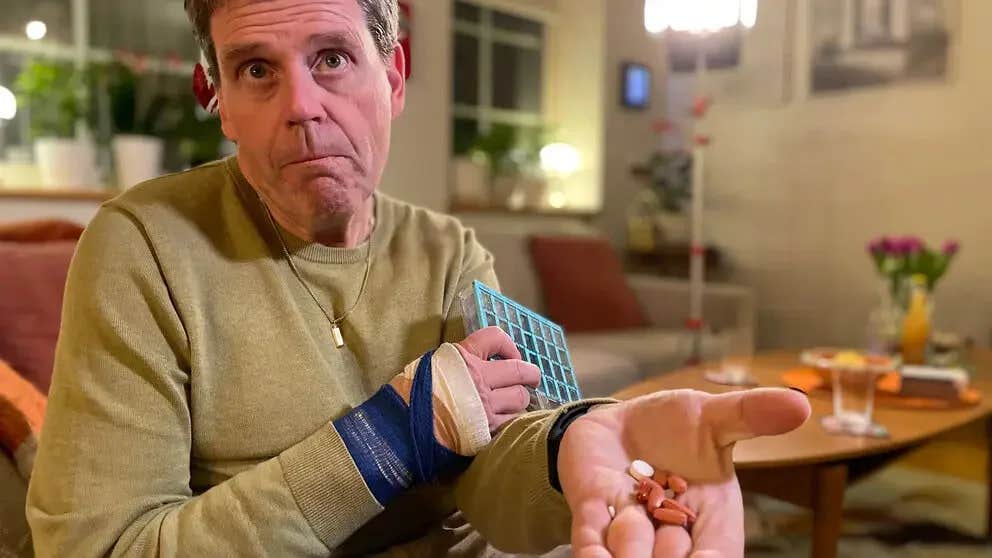Groundbreaking treatment enables Parkinson’s patient to move without constraints
A Swedish resident diagnosed with Parkinson’s, became the first person in the world to receive an implant of 7 million lab-grown brain cells

In 2023, Thomas Matsson, a Swedish resident diagnosed with Parkinson’s disease at the age of 42, became the first person in the world to receive an implant of 7 million lab-grown brain cells—a groundbreaking treatment developed by researchers at Lund University in Sweden.
This innovative approach, aiming to restore lost neurological function, has already shown promising results for Matsson, who now enjoys renewed abilities in smell and sports activities.
The Science Behind the Treatment
Parkinson's disease is a neurodegenerative disorder that primarily impairs motor function. The disease is characterized by the loss of dopamine-producing neurons in the brain, which are crucial for coordinating movements. The standard treatment has been drug therapy, which supplements dopamine levels but often comes with side effects and decreased effectiveness over time.
The new cell therapy at Lund University represents a shift from managing symptoms to potentially restoring lost functions. Researchers employ embryonic stem cells, exposed to growth factors that guide their development into immature dopamine neurons. These cells are then surgically implanted into a specific area of the brain close to the brain stem, where they begin to integrate into the brain's neural network and produce dopamine.
Matsson's Journey and Initial Results
Matsson’s treatment journey began with a complex 13-hour surgical procedure, after which he experienced a challenging recovery, including a temporary psychosis. Despite these initial difficulties, the long-term outcomes appear promising.
"The syrup is gone. I’ve got my 7 million cells and they are starting to work now,” Matsson explained. His renewed vitality is evident as he now engages in sports like golf, long-distance skating, and padel tennis—activities that were nearly impossible for him over the past two decades.
Potential Risks and Future Prospects
With any pioneering medical treatment, risks are involved. Gesine Paul-Visse, a senior physician at Skåne University Hospital and an adjunct professor at Lund University, noted concerns about the potential for tumor development and the possibility of producing excessive dopamine. However, these risks are considered low, and the benefits potentially transformative.
Related Stories
The initial phase of this research involved Matsson and four other patients, with plans to escalate the treatment to include higher doses of cells in future patients.
If successful, the therapy could proceed to larger trials in collaboration with a pharmaceutical company. The goal is to develop the treatment into a standardized medication available globally within the next seven to ten years.
Community Response and Future Outlook
The response from the Parkinson’s community has been overwhelmingly positive, with many patients expressing a desire to participate in the ongoing studies. Paul-Visse shared the enthusiasm and optimism surrounding the trials, emphasizing the potential for a substantial improvement in the quality of life for patients.
This pioneering treatment not only offers hope to those affected by Parkinson's but also represents a significant advancement in the field of regenerative medicine. As the research progresses, it holds the promise of transforming the lives of millions suffering from neurodegenerative diseases by repairing damaged tissues and restoring lost functions.
Symptoms of Parkinson's Disease
According to the Mayo Clinic, Parkinson's disease symptoms can be different for everyone. Early symptoms may be mild and go unnoticed. Symptoms often begin on one side of the body and usually remain worse on that side, even after symptoms begin to affect the limbs on both sides.
Parkinson's symptoms may include:
Tremor. Rhythmic shaking, called tremor, usually begins in a limb, often your hand or fingers. You may rub your thumb and forefinger back and forth. This is known as a pill-rolling tremor. Your hand may tremble when it's at rest. The shaking may decrease when you are performing tasks.
Slowed movement, known as bradykinesia. Over time, Parkinson's disease may slow your movement, making simple tasks difficult and time-consuming. Your steps may become shorter when you walk. It may be difficult to get out of a chair. You may drag or shuffle your feet as you try to walk.
Rigid muscles. Muscle stiffness may occur in any part of your body. The stiff muscles can be painful and limit your range of motion.
Impaired posture and balance. Your posture may become stooped. Or you may fall or have balance problems as a result of Parkinson's disease.
Loss of automatic movements. You may have a decreased ability to perform unconscious movements, including blinking, smiling or swinging your arms when you walk.
Speech changes. You may speak softly or quickly, slur, or hesitate before talking. Your speech may be more of a monotone rather than have the usual speech patterns.
Writing changes. It may become hard to write, and your writing may appear small.
Causes of Parkinson's Disease
According to the Mayo Clinic, in Parkinson's disease, certain nerve cells called neurons in the brain gradually break down or die. Many of the symptoms of Parkinson's are due to a loss of neurons that produce a chemical messenger in your brain called dopamine. When dopamine levels decrease, it causes irregular brain activity, leading to problems with movement and other symptoms of Parkinson's disease.
The cause of Parkinson's disease is unknown, but several factors appear to play a role, including:
Genes. Researchers have identified specific genetic changes that can cause Parkinson's disease. But these are uncommon except in rare cases with many family members affected by Parkinson's disease.
However, certain gene variations appear to increase the risk of Parkinson's disease but with a relatively small risk of Parkinson's disease for each of these genetic markers.
Environmental triggers. Exposure to certain toxins or environmental factors may increase the risk of later Parkinson's disease, but the risk is small.
Researchers also have noted that many changes occur in the brains of people with Parkinson's disease, although it's not clear why these changes occur. These changes include:
The presence of Lewy bodies. Clumps of specific substances within brain cells are microscopic markers of Parkinson's disease. These are called Lewy bodies, and researchers believe these Lewy bodies hold an important clue to the cause of Parkinson's disease.
Alpha-synuclein found within Lewy bodies. Although many substances are found within Lewy bodies, scientists believe that an important one is the natural and widespread protein called alpha-synuclein, also called a-synuclein. It's found in all Lewy bodies in a clumped form that cells can't break down. This is currently an important focus among Parkinson's disease researchers. Researchers have found the clumped alpha-synuclein protein in the spinal fluid of people who later develop Parkinson's disease.
Risk factors of Parkinson's Disease
According to the Mayo Clinic, risk factors for Parkinson's disease include:
Age. Young adults rarely experience Parkinson's disease. It ordinarily begins in middle or late life, and the risk increases with age. People usually develop the disease around age 60 or older. If a young person does have Parkinson's disease, genetic counseling might be helpful in making family planning decisions. Work, social situations and medicine side effects are also different from those of an older person with Parkinson's disease and require special considerations.
Heredity. Having a close relative with Parkinson's disease increases the chances that you'll develop the disease. However, your risks are still small unless you have many relatives in your family with Parkinson's disease.
Sex. Men are more likely to develop Parkinson's disease than are women.
Exposure to toxins. Ongoing exposure to herbicides and pesticides may slightly increase your risk of Parkinson's disease.
Symptoms and risk factors can vary in severity and may overlap with other conditions, so it's important to consult a healthcare professional for proper diagnosis and treatment.
For more science news stories check out our New Discoveries section at The Brighter Side of News.
Note: Materials provided by The Physiological Society. Content may be edited for style and length.
Like these kind of feel good stories? Get the Brighter Side of News' newsletter.
Joshua Shavit
Science & Technology Writer | AI and Robotics Reporter
Joshua Shavit is a Los Angeles-based science and technology writer with a passion for exploring the breakthroughs shaping the future. As a contributor to The Brighter Side of News, he focuses on positive and transformative advancements in AI, technology, physics, engineering, robotics and space science. Joshua is currently working towards a Bachelor of Science in Business Administration at the University of California, Berkeley. He combines his academic background with a talent for storytelling, making complex scientific discoveries engaging and accessible. His work highlights the innovators behind the ideas, bringing readers closer to the people driving progress.



